|
|
|
|||
|
|
||||
|
|
||||
| The Smoky Addiction | ||||
|
|
HOME | SITE MAP | FORUM | CONTACT |
|
||
|
ABOUT | MOTORS | MODELS | ARCHIVE | HISTORY | STORE | FAQ | LINKS
|
|
|
|
|
|
|||||||||||||||||||||||||||||||||||||||||||||||||||||||||
|
The Smoky Addiction 9
(September 2005)
by Roger Simmonds Reprinted from SAM 35 Speaks, September 2005 First, here is an evocative image of Mike Stuart’s Skyleada Mystère IV on full throttle over Old Warden. The design is all of fifty years old, and, in contrast to contemporary models like Steve Bage’s Hawker P 1121 or Thunderchief, it has proved quite ‘floaty’ and will happily fly around on a low power (110mN) Rapier L2. Funf asks what ‘mN’ means – well it stands for ‘milliNewton’, the modern and unimperial measure of thrust. 1,000 of the little blighters manage to squeeze themselves into a single Newton, and (roughly speaking) 284 mN add up to a whole ounce of honest English thrust. So 110 mN is a little over |
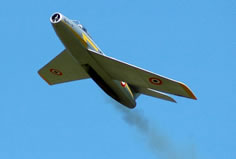 with afterburner
- Laurence Marks, July 2005
|
|||||||||||||||||||||||||||||||||||||||||||||||||||||||||
|
I am very fond of flying shots, and here are two splendid vintage examples from Mike Ingram’s archive. Bert Judge’s ‘Tailored’ Hunter for Jetmaster is coming in for a low pass [right] and below that Mike’s ‘Tailored’ Swift is climbing away nicely without reheat. These photos are surprisingly realistic; the graininess and absence of any trough – all too evident, alas, on the Mystère IV – adds to the verisimilitude, and only the dihedral gives the game away. It would be good to see Andy Blackwell’s Swift in the air for a photo call with a modern camera. Perhaps he will bring it to Middle Wallop. Returning to the inexhaustible subject of motors, Jan Zigmund has resurrected the Rapier L3. The motor is larger, though fortunately no more expensive, than the established L2, being 6.4 mm long and 14 mm in diameter. It weighs all of 15 g, but it is neater and better engineered than the comparatively unloved L4. A performance of 300 mN (over an ounce) for 20 seconds is claimed, so they should be suitable for those nice Skyleada models originally designed for the Jetex 100: the Comet, Canberra and Vulcan. |
 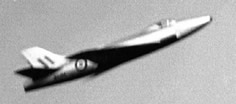
- Mike Ingram
|
|||||||||||||||||||||||||||||||||||||||||||||||||||||||||
|
|
|
|||
|
Being fond of photos of models in action, I like this one of Dick Twomey’s latest Twizzler, even if it is ersatz. The model is, I hasten to add, genuine, but John Miller Crawford has replaced the originally rather cluttered background with something more appropriate. Dick writes: “As you can see the rebuilt Twizzler has a Lever Jet-X […] it hasn’t flown yet. The original was powered with a Jetex 200 and won the RAF Training Command Team Trials in 1951. Its longest (ever) flight was 8:05 on 20 seconds of fizz. Incidentally, ‘Twizzler’ was not the name I’d chosen, but an unwelcome re-christening by the Aeromodeller. I’d dubbed it ‘Firebrand’ as it was almost a straight slimmed down Firecrest after all! I remember being angry with AM but not verbally, and so I got my cheque. Had I been braver at the time I’d have said that ‘twizzling’ in no way fitted with my flight pattern plan of a straight climb and circling glide.” I wonder why the AM changed its moniker – was it something they often did? |
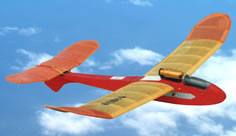 for Jet-X 100
- Dick Twomey, retouched JMC
|
|||
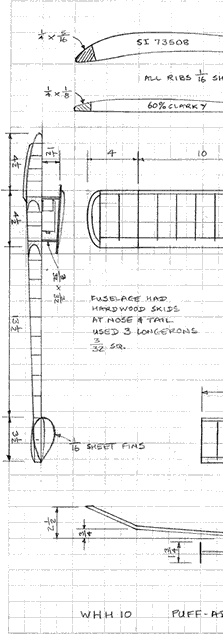
“I was handicapped due to having no full size plans. I remembered some details, but many needed creative recall based on photos. First and foremost I had to recheck the major dimensions. “[Fortunately] the photo of myself with the other winners at the first Jetex International contest [see the Smoky Addiction, July 2005] has almost a plan view of the model and the dimensions checked out very well. The major problem with the original model was that the wing had to be taken off each time the motor was reloaded. I solved this on the Vindscreenviper by riveting a ply base to the motor and sliding this assembly into place using runners. I elected to use the same system in Puff Adder 2B. Another problem was the weak wings, due to my using no spars. This was common practice for small duration models in the late forties and I note that Dick Twomey used the same technique. I have used designer’s licence and included a single spar in the wing and tailplane. [Yet] another problem was that we must now have the DT fuse mounted in a snuffer tube […] thus the rear end of the fuselage is now different from the original. I recognise that many of these changes would not be acceptable to SAM, but the 50+ years of model building knowledge I have acquired since 1949 will not permit me to build in the mistakes I made at 18! I have also re-evaluated other design decisions, particularly as to the grade and density of wood to use in various components. The original was covered in Modelspan, the only tissue then available, which was heavy and soaked up a lot of dope. Around 1950 I converted to Japanese tissue, so the [new] model is covered using Jap tissue, but in the original red and white combination”. Bill then applied to his considerable skills to the Vindskreenviper, a larger and more sophisticated design for the Jetex 350 (or Scorpion). Bill found a few minor errors in the Vindskreenviper II plan published by the Aeromodeller (a Roman numeral was added by AM). These were mostly in the nomenclature, but some fuselage details were also incorrect. Bill continues: |
|
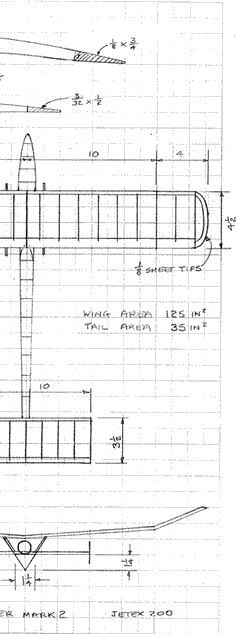 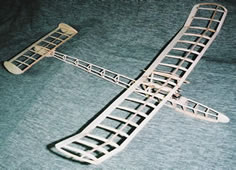  for John Emmetís rebuilt Jetex 200
- Bill Henderson
|
||
|
“I was very surprised at how difficult it was to build. The pylon brought back memories of the same problems on the original model. With the size of the motor and difficulty of construction it is not surprising that very few were built. In contrast, Ian Dowsett’s designs were all very simple and were justifiably popular”. Bill decided to modify a Vindskreenviper 3 fuselage to take his new (2B) wings. The Vindskreenviper 3 was designed for the Scorpion, but Bill had obviously been disappointed with this design and has hopes that the 2B wings, which have less area than the original Mk 3 wings, will allow for a faster climb and perhaps the model will fly better. At the time of writing none of the models had flown under power, but Bill reports that glide tests are encouraging: “I got Puff Adder 2B into glide trim with 19 grams of nose weight, which is less than I expected. I also had to play with the wing incidence and decalage and these are now much closer to the original model. Much to my surprise the Vindskreenviper 2B proved slightly nose heavy. This was corrected by adding 1 mm shim at the stab TE. It now has a very pleasing flat glide from hand launch. The new version is 1 oz lighter than the original!” Which just goes to show what can be achieved after 50+ years of modelling experience! This is an inspirational story and I was pleased Bill did not resist the temptation to rethink and make improvements to his original creations. The full saga, with plans for both the Puff Adder and Vindscreenviper, is available on Jetex.org, and I am happy to print out the unadulterated original for any interested reader without internet access. For those without a Jetex 200 or 350, whether vintage or John Emmett’s meticulous rebuilds, there is always the option to build reduced versions of these models for Rapier power. The Puff Adder, the simpler of the two, was originally for Jetex 200, so it should be reduced to about 80% for the new L3. Even at this size, with the promised 20 seconds of fizz, a DT will be essential. Thud! Or the subtle art of trimming In an early (Jet)X Files (April 2003), I lamented that we appeared to have lost some of the arts of trimming small jet planes. I came to this conclusion after watching two gentlemen trying to tame the persistent looping of an Me 163. I thought then, and still do, that we should employ techniques more sophisticated than just adding great lumps of unsightly Blu-Tack to the nose. But at that time I had little apprehension of what these might be. |
|
 for Jetex Scorpion.
- Bill Henderson
|
||
|
My disdain for these gentlemen’s best efforts was also a little unfair, as the Aerographics Me 163, if built according to the plan, can be a somewhat intransigent model, and it is better behaved if the reflex is reduced to Bert Judge used vanes in the augmenter tube of his tailored F-104 and Crusader, necessary, he said, “to keep the nose up”, and Howard Metcalfe had a ‘thrust deflector tab’ on his profile F-104. I had yet to see one, though, on a modern built-up model with a trough – that is, until Mike Stuart’s Thunderchief. This beautifully made and sophisticated model weighs only 26 g [right]. I’ll let Mike tell the story of the somewhat fraught first test flights at Old Warden Proving Grounds: “Despite a steep glide, powered flight with a 110 mN motor resulted in lots of stalling, so a blob of clay was removed from the tail and added to the nose. It needed a bit more nose weight to get a proper steady powered flight, and a 110 mN was not enough grunt to keep up flying speed, so I tried a 120 – which looked better – and then a 130, which gave a couple of decent flights. [The model] appears very sensitive to nose weight, but is stable in roll, with lateral stability to spare, and copes with breezy conditions well. It takes a while to gain height after launch – it needs to fly quite fast, and takes time to get going – so a catapult launch might be a good idea to get it up to speed quickly. It looks great under power, but its Achilles heel [at the moment] is that as soon as the power cuts it does not so much glide as plummet and it makes a great lawn dart!” |
|
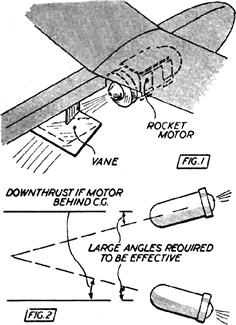
- Model Aircraft, March 1956
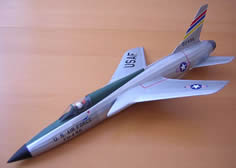 Mike Stuart’s Thunderchief for Rapier L2
- Mike Stuart
|
||
|
Having ‘explored ‘the outside of the envelope’ (to use Chuck Yeager’s phrase) Mike went home with some serious thinking to do. Whilst the Thud’s ‘dead stick’ behaviour is by all accounts quite authentic (the full size machine had a glide like a bunch of car keys), it is undesirable in a model. Steve and I suggested that the Thunderchief was perfect for ‘trimming nose up and using downthrust to kill the power stall’. Mike modified his trough accordingly (see right), and took his modified, but untested, model to Woodvale, there to take part in the prestigious Eddie Riding Trophy. Having assured himself of victory in rubber with his Mr Mulligan, Mike turned his attention to the Rapier Cup. Below is his (edited) report: “The wind was still around 10 mph at 6 pm with turbulent air coming off the trees. I was delighted that there were two other Rapier entrants, both flying MIG 15s. Paul Bingham broke his after a heavy landing, but James Campbell got two amazing flights. He must have been using L2HP motors because it went up in a spiral climb like a duration model. Both flights were over a very impressive 40 seconds. Trimming the Thunderchief in windy conditions was not easy, as the flights were inconsistent and affected by gusts. However, with the downthrust tab I was able to improve the glide by adding weight to the tailpipe, and the crowd got plenty of entertainment as I used up a whole box of 140 mN rated motors. Many flights were double, involving the famous, ’throw, run, pick up and throw again’ routine. Fortunately the qualifying time for Rapier models is only 15 seconds, and flights are judged on realism, not duration. There are four sets of judges and you can have two attempts with each. After using up six attempts I still had not got the required 15 seconds – the nearest being 12 seconds when I forgot to put the underfin back after cleaning. Without the downthrust tab the model roared off into the sky and performed various exciting aerobatics until it went a loop too far and did its lawn dart impression. So, with only one set of judges left, I did some more trimming and finally got a really good flight after two attempts [Mike does not say what changes he made to achieve this]. These were not judged, so not official, of course. Surely the Thud would behave now? […] Over to the judges, handover form, light motor, launch model. It blew out of my hand into a gust – up and straight down again. Getting a bit tense now – got to launch it correctly – not too far up. Lit motor, launched, straight into the ground. [!] Run, pick up, launch, and this time the Thud whipped round in a climbing turn into the wind and kept climbing until the power ran out. It was reasonably high, so I kept asking it to please please please glide nicely. And it did (aren’t downthrust tabs wonderful?). I knew it was close; when I returned to the judges they told me it had been exactly 15 seconds. Talk about taking it to the wire! So I ended up winning the Rapier cup again helped by a good set of scale points […] an excellent event made even better by the fact that both models sustained only minor damage.” This is a grand piece of writing. Jetex type scale models much prefer calm conditions, but what a wonderful model Bill Dean’s MiG 15 still is! Maybe next year we will see more Rapier models at Woodvale. Mike’s experiences confirm the 1956 MA article’s views on the usefulness of ‘exhaust-controlled vanes,’ downthrust tabs, or whatever one calls them. They obviously work well and are one answer to the dreaded power stall, loop, or ‘zoom to doom’. Expect to see more of them. Even aluminium vanes appear to withstand Rapier exhaust well, and they can also protect an otherwise quite exposed underfin. My fears concerning the Thud’s trough (see July’s column) appear unfounded, and its narrowness may even ameliorate asymmetric thrust from distorted orifices. We obviously need to think about the configuration of our troughs more carefully, and, if they are to receive the direct blast of our motors, at least consider using steel instead of aluminium. Derek Knight has lined the trough of his Swift with 001" steel, using Stubbs ‘Shim in a Can’. There was, he says, little weight penalty and no change in trim. Shim is quite expensive at £35 for a 6" × 50" roll, but steel should be very durable and reasonably economical in the long run. Perhaps a group of us could get together to buy a tin. |
|
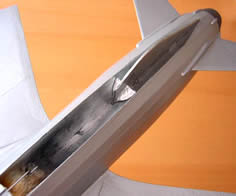 The downthrust tab is at an angle of about 45° and fits a slot in the underfin
- Mike Stuart
|
||
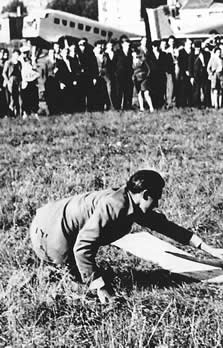
I recently acquired a copy of The original caption reads, “Georges Bougueret releases his elegant twin boomer propelled by a Ruggieri rocket […] The disadvantage of these rockets was that they exploded every so often (‘de temps en temps’) [!]. Does anybody know any more about the Ruggieri motors or have access to a 3-view of his ‘elegant’ model? |
|
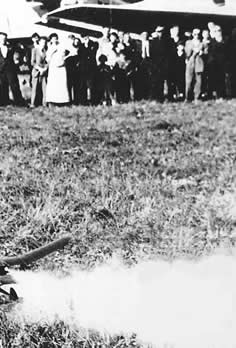 Georges Bougueret at Issy les Moulineaux, 1946
- La Grande Histoire des Petits Avions, 1946 (p. 69)
|
||
|
|
||||
|
|
|
|||
|
|
|
|
|
|
|
|
Acknowledgements - Article: Roger Simmonds - Illustrations: Roger Simmonds, Mike Ingram, Laurence Marks, Mike Stuart, Dick Twomey |
|
|
|
|
ABOUT | MOTORS | MODELS | ARCHIVE | HISTORY | STORE | FAQ | LINKS |
|
|
Terms of Use
|
Queries? Corrections? Additions?
Please
contact us.
|
|